INSTITUT SUPERIEUR D'ANTHROPOLOGIE
INSTITUTE OF ANTHROPOLOGY
ONLINE COURSES / COURS A DISTANCE
SPRING TERM : APRIL 2015
REGISTER NOW
ISRAEL – 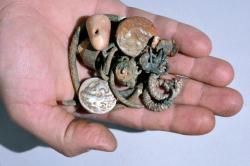 Galilee -Explorers from the Israeli Caving Club found a unique treasure trove of silver coins, rings, bracelets and earrings, hidden in a secluded stalactite cave in Israel's Galilee region some 2,300 years ago. The valuables, dating back to the era of Alexander the Great, were possibly hidden during the unrest that followed after the death of the Macedonian king. Archaeologists also unearthed bronze items dating as far back as 5,000 years in the same cave over the weekend. Numerous pottery vessels, as well as agate gemstones and an oil lamp were found nearby. Experts said that more discoveries are likely to follow since the area remains largely unexplored. The exact location of the cave has not been made public.
Galilee -Explorers from the Israeli Caving Club found a unique treasure trove of silver coins, rings, bracelets and earrings, hidden in a secluded stalactite cave in Israel's Galilee region some 2,300 years ago. The valuables, dating back to the era of Alexander the Great, were possibly hidden during the unrest that followed after the death of the Macedonian king. Archaeologists also unearthed bronze items dating as far back as 5,000 years in the same cave over the weekend. Numerous pottery vessels, as well as agate gemstones and an oil lamp were found nearby. Experts said that more discoveries are likely to follow since the area remains largely unexplored. The exact location of the cave has not been made public.
http://sputniknews.com/art_living/20150309/1019263753.html?
TURQUIE – 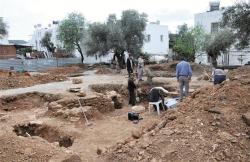 Bodrum - Excavations carried out over the last six months in the western province of Muğla’s Bodrum district unearthed rock tombs from various eras, a historic figurine on a rock and artifacts from the early Bronze Age. Fifteen Pithos tombs from the early Bronze Age were unearthed in the Gümüşlük neighborhood of the Çukurbük area. Gifts for the dead and tear bottles found in the tombs were put under protection. A Pithos tomb was a large storage container used to preserve liquid products and dry agricultural products in ancient ages. However, they were mostly used as graves in the region. A rock tomb was also found on Şalvarağa Hill, while environmental work around the tomb revealed another rock tomb. Traces show that the area could have been a necropolis area, or a large ancient cemetery with tomb monuments. Ten more tombs from the Hellenistic era were revealed on the land next to the District Police Department. It was reported that the skeletons in the area were being examined by archaeologists. A male figurine was found on a rock in the Yalıkavak neighborhood. It was reported that there was dense debris around the figurine. The figurine, which was found during the salvage excavations, is thought to be the god of fertility. The 2,600-year-old figurine depicts a man holding a glass. The examinations around the rock revealed that ancient women who failed to become pregnant went there and made vows.
Bodrum - Excavations carried out over the last six months in the western province of Muğla’s Bodrum district unearthed rock tombs from various eras, a historic figurine on a rock and artifacts from the early Bronze Age. Fifteen Pithos tombs from the early Bronze Age were unearthed in the Gümüşlük neighborhood of the Çukurbük area. Gifts for the dead and tear bottles found in the tombs were put under protection. A Pithos tomb was a large storage container used to preserve liquid products and dry agricultural products in ancient ages. However, they were mostly used as graves in the region. A rock tomb was also found on Şalvarağa Hill, while environmental work around the tomb revealed another rock tomb. Traces show that the area could have been a necropolis area, or a large ancient cemetery with tomb monuments. Ten more tombs from the Hellenistic era were revealed on the land next to the District Police Department. It was reported that the skeletons in the area were being examined by archaeologists. A male figurine was found on a rock in the Yalıkavak neighborhood. It was reported that there was dense debris around the figurine. The figurine, which was found during the salvage excavations, is thought to be the god of fertility. The 2,600-year-old figurine depicts a man holding a glass. The examinations around the rock revealed that ancient women who failed to become pregnant went there and made vows.
http://www.hurriyetdailynews.com/bodrum-excavations-reveal-rich-history-.aspx?pageID=238&nid=79412&NewsCatID=375
HONDURAS – 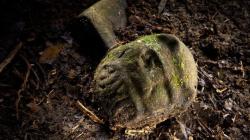 Ciudad Blanca- Honduran archaeologists doubt that an archeological site in Mosquitia region found by a National Geographic Society team is the legendary "Ciudad Blanca" – or White City – that for decades has been talked about in the Central American country. The country, according to experts here, has numerous archaeological sites and most of them have not been discovered, while the country has limited resources to support this kind of research. After 100 years of digs, only about 10 percent of the Copán archaeological park, located in western Honduras and home to extensive stone structures from the Maya civilization, has been explored. The discovery reported by National Geographic could correspond to different sites that extend from La Mosquitia, part of which is in Gracias a Díos province, into Nicaragua, Castro said. In 1994, explorers found a cave in Gracias a Díos and an underground river with skulls that shine as a result of the humid environment and other effects of time. The Cuevas de Talgua caverns, according to some Honduran archaeologists, may contain traces of a community that lived in the area around 900 B.C. Some archaeologists say that some clay and stone pieces found in Olancho may belong to the pre-Columbian Olmec culture. The discovery, reported by National Geographic last week, includes hieroglyphs with images of animals, pyramids and squares, INAH officials said.
Ciudad Blanca- Honduran archaeologists doubt that an archeological site in Mosquitia region found by a National Geographic Society team is the legendary "Ciudad Blanca" – or White City – that for decades has been talked about in the Central American country. The country, according to experts here, has numerous archaeological sites and most of them have not been discovered, while the country has limited resources to support this kind of research. After 100 years of digs, only about 10 percent of the Copán archaeological park, located in western Honduras and home to extensive stone structures from the Maya civilization, has been explored. The discovery reported by National Geographic could correspond to different sites that extend from La Mosquitia, part of which is in Gracias a Díos province, into Nicaragua, Castro said. In 1994, explorers found a cave in Gracias a Díos and an underground river with skulls that shine as a result of the humid environment and other effects of time. The Cuevas de Talgua caverns, according to some Honduran archaeologists, may contain traces of a community that lived in the area around 900 B.C. Some archaeologists say that some clay and stone pieces found in Olancho may belong to the pre-Columbian Olmec culture. The discovery, reported by National Geographic last week, includes hieroglyphs with images of animals, pyramids and squares, INAH officials said.
http://latino.foxnews.com/latino/entertainment/2015/03/09/honduran-archaeologists-doubt-national-geographic-find-is-legendary/
ROYAUME UNI –  Rufford Abbey - A stone stump used as a photo tripod by country park visitors is an ancient Roman artefact, it has been revealed. Archaeologists said the 4ft (1.2m) granite stone at Rufford Abbey, near Ollerton, Nottinghamshire, dates back to about 150AD. It formed part of a column at Roman emperor Antoninus Pius' villa, excavated and brought back by 19th Century archaeologist Lord John Savile.
Rufford Abbey - A stone stump used as a photo tripod by country park visitors is an ancient Roman artefact, it has been revealed. Archaeologists said the 4ft (1.2m) granite stone at Rufford Abbey, near Ollerton, Nottinghamshire, dates back to about 150AD. It formed part of a column at Roman emperor Antoninus Pius' villa, excavated and brought back by 19th Century archaeologist Lord John Savile.
http://www.bbc.co.uk/news/uk-england-nottinghamshire-31793989
FRANCE –  Toulouse - Pourquoi s'intéresser aux cloîtres romans du XIIe siècle ?Parce que Toulouse a été une ville exceptionnelle au niveau européen à cette époque pour laquelle le champ des recherches archéologiques est immense. Après l'essor de la ville antique autour du cardo romain, les pôles religieux ont restructuré la ville. Entre 1 100 et 1130, la cathédrale Saint-Etienne, le monastère bénédictin de la Daurade et la collégiale Saint-Sernin se sont dotés de cloîtres exceptionnels, sur le modèle de celui de Moissac. Mais entre 1 799 et 1811, tous ont été détruits, soit à cause du symbole religieux qu'ils représentaient soit du fait de la promotion immobilière du 1er empire : les chapiteaux magnifiques qui ont survécu font la renommée mondiale du musée des Augustins. Quand on fait des fouilles à Toulouse, on découvre un monde nouveau, qui bouscule les idées préconçues sur la ville. Ce chantier prévoit un décaissement de la place sur 80 cm, sans parler de tranchées plus profondes. Or, au XIXe siècle, le niveau de la place a été baissé d'un mètre. On tombe donc tout de suite sur un niveau intéressant. Le recteur de l'institut pontifical d'archéologie chrétienne de Rome a jugé le site de Saint-Sernin comme majeur au niveau européen et l'avait écrit au maire Dominique Baudis. La métropole toulousaine et son million d'habitants méritent de vraies fouilles comme Rome, Barcelone ou Saragosse. C'est une chance culturelle et touristique pour Toulouse, à l'heure où elle se revendique comme site mondial Unesco.
Toulouse - Pourquoi s'intéresser aux cloîtres romans du XIIe siècle ?Parce que Toulouse a été une ville exceptionnelle au niveau européen à cette époque pour laquelle le champ des recherches archéologiques est immense. Après l'essor de la ville antique autour du cardo romain, les pôles religieux ont restructuré la ville. Entre 1 100 et 1130, la cathédrale Saint-Etienne, le monastère bénédictin de la Daurade et la collégiale Saint-Sernin se sont dotés de cloîtres exceptionnels, sur le modèle de celui de Moissac. Mais entre 1 799 et 1811, tous ont été détruits, soit à cause du symbole religieux qu'ils représentaient soit du fait de la promotion immobilière du 1er empire : les chapiteaux magnifiques qui ont survécu font la renommée mondiale du musée des Augustins. Quand on fait des fouilles à Toulouse, on découvre un monde nouveau, qui bouscule les idées préconçues sur la ville. Ce chantier prévoit un décaissement de la place sur 80 cm, sans parler de tranchées plus profondes. Or, au XIXe siècle, le niveau de la place a été baissé d'un mètre. On tombe donc tout de suite sur un niveau intéressant. Le recteur de l'institut pontifical d'archéologie chrétienne de Rome a jugé le site de Saint-Sernin comme majeur au niveau européen et l'avait écrit au maire Dominique Baudis. La métropole toulousaine et son million d'habitants méritent de vraies fouilles comme Rome, Barcelone ou Saragosse. C'est une chance culturelle et touristique pour Toulouse, à l'heure où elle se revendique comme site mondial Unesco.
http://www.ladepeche.fr/article/2015/03/09/2063052-il-faut-des-fouilles-a-saint-sernin.html
ITALIE – 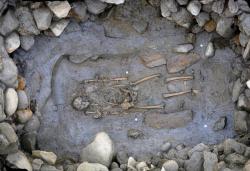 Aoste - Les ouvriers du chantier pour la construction du nouvel hôpital ont mis à jour un tumulus important de 18 mètres de diamètre.A l’intérieur, les archéologues ont découvert le squelette d’un guerrier celte à côté de son épée en fer.« Jamais un tel tombeau a été découvert au sud des Alpes. Par l’analyse des os et l’étude en laboratoire des matériels métalliques, on pourra mieux comprendre la provenance du guerrier », a déclaré le surintendant aux Biens culturels de la Région autonome de la Vallée d’Aoste.
Aoste - Les ouvriers du chantier pour la construction du nouvel hôpital ont mis à jour un tumulus important de 18 mètres de diamètre.A l’intérieur, les archéologues ont découvert le squelette d’un guerrier celte à côté de son épée en fer.« Jamais un tel tombeau a été découvert au sud des Alpes. Par l’analyse des os et l’étude en laboratoire des matériels métalliques, on pourra mieux comprendre la provenance du guerrier », a déclaré le surintendant aux Biens culturels de la Région autonome de la Vallée d’Aoste.
http://www.ledauphine.com/haute-savoie/2015/03/09/un-tombeau-celte-decouvert-sous-l-hopital-d-aoste
ITALIE – 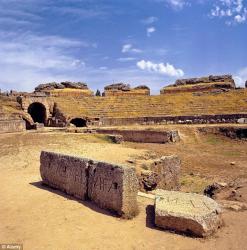 Rome -Producers working on the remake of the Oscar-winning Ben Hur have been barred from shooting the epic chariot scene at the Circus Maximus. Filmmakers already on location in Rome and the southern city of Matera reportedly made a request to use the ancient stadium immortalised by the film in December. But it was feared the decision to bring hundreds of extras and heavy vehicles into a fragile archaeological site would lead to public outcry. The Circus Maximus was capable of holding hundreds of thousands of spectators during the chariot races.
Rome -Producers working on the remake of the Oscar-winning Ben Hur have been barred from shooting the epic chariot scene at the Circus Maximus. Filmmakers already on location in Rome and the southern city of Matera reportedly made a request to use the ancient stadium immortalised by the film in December. But it was feared the decision to bring hundreds of extras and heavy vehicles into a fragile archaeological site would lead to public outcry. The Circus Maximus was capable of holding hundreds of thousands of spectators during the chariot races.
http://www.dailymail.co.uk/news/article-2986596/Ben-Hur-producers-BANNED-filming-remake-Rome-s-ancient-chariot-racing-arena-Circus-Maximus.html?ITO=1490&ns_mchannel=rss&ns_campaign=1490